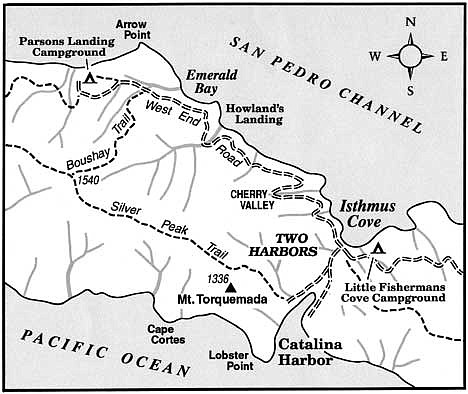 Facebook
Facebook
 X
X
 Instagram
Instagram
 TikTok
TikTok
 Youtube
Youtube
Parsons Landing on Santa Catalina Island is not only the site of a small beach and a spacious camping area; it is also the home of one of the best examples of native Southern California grassland habitat. Gray-green after winter rains, bleached gray during drought, the perennial grasses here thrive with the right combination of fine-grained soil, soaking winter rains, desiccating summer drought, and the absence of much grazing in the past by domestic and feral animals.
The native grasslands of Parsons Landing are only one example of the botanical richness and diversity of the north slope of Catalina's west end. On these sheltered, north-facing slopes, you'll find plenty of luxuriant chaparral vegetation -- most notably Catalina cherry, a large shrub or tree displaying spike-shaped clusters of white flowers in the springtime. Its dark, red fruits, which mature in summer, resemble large black cherries.
First, of course, you'll need to navigate to the island itself. Visit the Santa Catalina Island Company's website (www.scico.com) to help with your plans and needed reservations. You'll need to drive to the port of San Pedro, catch a Catalina Express ferry to Two Harbors on the narrow isthmus of the island, and either lodge in Two Harbors or camp at nearby Little Fishermans Cove Campround or remote Parsons Landing Campground.
Parsons Landing Campground, accessible by foot from Two Harbors either as a day hike or as an overnight backpack, involves a trek of seven miles one-way on a gently graded dirt road. The road hugs the shoreline, circuitously swinging around every ravine and canyon along the way, offering ever-changing perspectives of interface of land and sea. Early on, the route detours into Cherry Valley, where plenty of cherry trees grow to heights of 30 feet or more. Later, you'll pass several organizational camps and private marinas.
Nearing seven miles in, the dirt road bends left (southwest) and you continue going straight (west) on a trail through grassland to the scattered camp and picnic sites of Parsons Landing. There are eight campsites on the beach here, with a capacity of six persons per site. Overnighters are provided with picnic tables, fire rings, barbecue units, and chemical toilets (no showers, though). No fresh water is on tap; however, firewood and bottled water are accessible via lock box for registered campers. All other supplies must be carried in.
A night spent at Parsons Landing is a rare treat -- a wilderness experience on a Southern California beach. A two-night stay here facilitates the exploration of Santa Catalina Island's remote and rugged spine and far west end via day hikes on primitive routes such as the Boushay and Silver Peak trails.


Parsons Landing on Santa Catalina Island is not only the site of a small beach and a spacious camping area; it is also the home of one of the best examples of native Southern California grassland habitat. Gray-green after winter rains, bleached gray during drought, the perennial grasses here thrive with the right combination of fine-grained soil, soaking winter rains, desiccating summer drought, and the absence of much grazing in the past by domestic and feral animals.
The native grasslands of Parsons Landing are only one example of the botanical richness and diversity of the north slope of Catalina's west end. On these sheltered, north-facing slopes, you'll find plenty of luxuriant chaparral vegetation -- most notably Catalina cherry, a large shrub or tree displaying spike-shaped clusters of white flowers in the springtime. Its dark, red fruits, which mature in summer, resemble large black cherries.
First, of course, you'll need to navigate to the island itself. Visit the Santa Catalina Island Company's website (www.scico.com) to help with your plans and needed reservations. You'll need to drive to the port of San Pedro, catch a Catalina Express ferry to Two Harbors on the narrow isthmus of the island, and either lodge in Two Harbors or camp at nearby Little Fishermans Cove Campround or remote Parsons Landing Campground.
Parsons Landing Campground, accessible by foot from Two Harbors either as a day hike or as an overnight backpack, involves a trek of seven miles one-way on a gently graded dirt road. The road hugs the shoreline, circuitously swinging around every ravine and canyon along the way, offering ever-changing perspectives of interface of land and sea. Early on, the route detours into Cherry Valley, where plenty of cherry trees grow to heights of 30 feet or more. Later, you'll pass several organizational camps and private marinas.
Nearing seven miles in, the dirt road bends left (southwest) and you continue going straight (west) on a trail through grassland to the scattered camp and picnic sites of Parsons Landing. There are eight campsites on the beach here, with a capacity of six persons per site. Overnighters are provided with picnic tables, fire rings, barbecue units, and chemical toilets (no showers, though). No fresh water is on tap; however, firewood and bottled water are accessible via lock box for registered campers. All other supplies must be carried in.
A night spent at Parsons Landing is a rare treat -- a wilderness experience on a Southern California beach. A two-night stay here facilitates the exploration of Santa Catalina Island's remote and rugged spine and far west end via day hikes on primitive routes such as the Boushay and Silver Peak trails.
